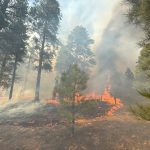
Groundbreaking sets sights on ’24 fall opening
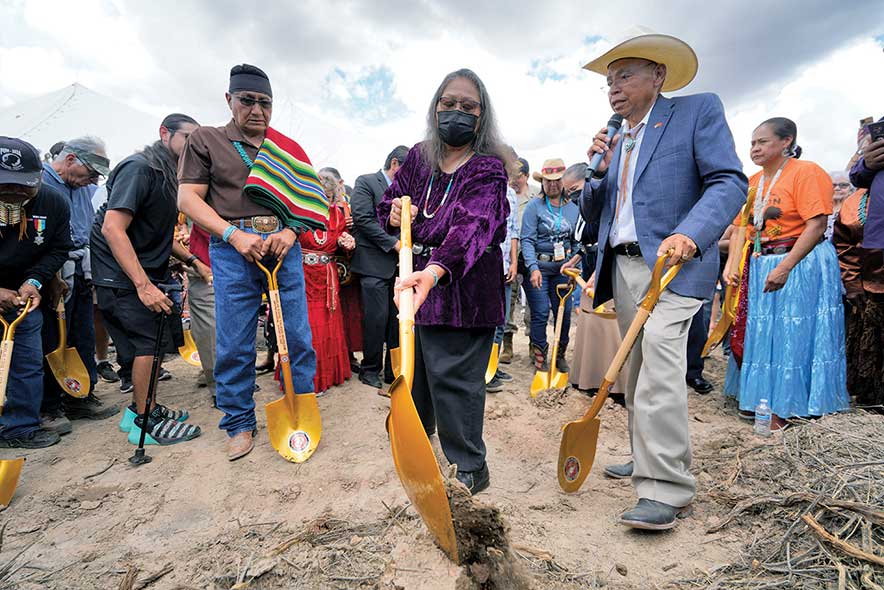
Navajo Times | Donovan Quintero
Malula Sandoval, wife of the late Navajo Code Talker Samuel Sandoval, from Shiprock, places dirt onto a pile of dirt during a Navajo Code Talkers Museum groundbreaking ceremony in Tse Bonito, N.M.
TSE BONITO, N.M.
Nearly 13 years after Chevron donated 208 acres to the Navajo Code Talkers, their legacy was solidified with a groundbreaking ceremony that officially set the path for a future museum.
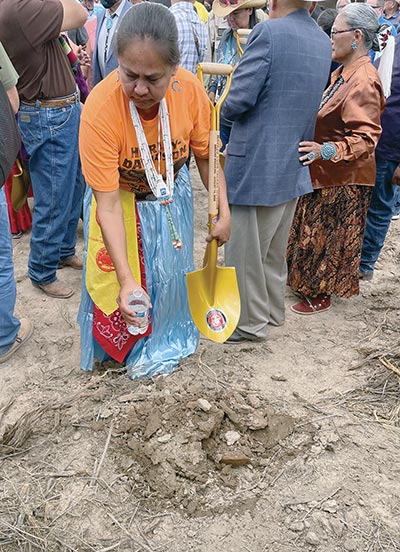
Navajo Times | Donovan Quintero
New Mexico State Sen. Shannon Pinto pours water onto a pile of dirt placed by Navajo Code Talkers Museum groundbreaking participants on National Navajo Code Talkers Day in Tse Bonito, N.M.
On Sunday, Malula Sandoval, New Mexico state Sen. Shannon Pinto, the granddaughter of the late Sen. John Pinto, and Peter MacDonald Sr., christened the ground where the future Navajo Code Talker Museum would be built.
Malula lost her husband, the late Navajo Code Talker Samuel Sandoval, almost three weeks ago.
Of the more than 400 Navajo men who used the Navajo language as a code during World War II, only three remain – John Kinsel Sr, 105, Thomas H. Begay, 98, and MacDonald, 97.
Samuel Sandoval, who had intended to put a shovel into the ground for a museum, according to his wife, died nearly three weeks shy of the museum groundbreaking, on July 29, at the age of 98.
Malula, wearing a purple blouse decorated with a red, white, and blue necklace and a concho belt, quietly scooped dirt with her gold-painted shovel and placed it on a bigger pile before walking away to make room for others.
Thumbs up
Before the ceremony, Sen. Pinto hugged her for a moment.
Pinto gave a thumbs up when asked how she felt after the groundbreaking, which she did on behalf of her late grandfather.
“He (John Pinto) did that when he felt accomplished,” Pinto said. “This was something successful.”
She said she intended to bring the shovel back to the site when the museum was built, which is expected to cost $50 million.
“I know it’s a big push, but I think we can get the support,” she said of the projected debut of the museum in the fall of 2024.
“I think from all entities, I don’t know if Arizona will put in on this,” she said, “but with the Nation, New Mexico state government, McKinley County, and maybe the city too, and the help of our people, I think it’s doable.”
When the land was donated in 2009 through a proclamation signed by the late Navajo Code Talker Keith Little and Frederick Nelson of Chevron, the former Navajo Code Talker Association, a nonprofit organization, had about $700,000 for the museum, according to an August 2009 Navajo Times article.
Little told the Navajo Times the association hoped to raise an additional $20 million, $40 million shy of expected costs.
But the association was required to operate as a charity organization and to have a high percentage of code talkers as active members.
Because the land was donated to the association, which lost its standing as a nonprofit, dreams of building a museum halted.
Little died three years after the land transfer on Jan. 3, 2012. He was 87.
Land issues
Speaker Seth Damon on Sunday said since the land was donated to the code talker association, the tribal government could not help because it was not Navajo Nation-owned land.
Seven years after Little’s death, Damon said MacDonald and Sandoval came to his office, asking if a budget could be put together so funding John Pinto had gotten for a code talker museum could go to them.
“They thought the senator gave it directly to them, that $1.2 million, and gave it directly to the foundation,” Damon said. “Unfortunately, it was given to the Navajo Nation through capital outlay funds.”
Shannon Pinto, in 2019, asked for New Mexico Gov. Michelle Lujan Grisham’s support in getting the museum project off the ground.
Grisham committed a half million dollars of capital outlay funds. Another $526,000 was pledged by state legislators.
Damon said MacDonald and Sandoval were frustrated.
In 2020, the Navajo Code Talkers Museum LLC., a 501(c)(3) corporation, was created, and MacDonald was named president.
The land was placed under the organization after being put back into good standing.
“Once they got back in good standing, then they found out, ‘OK, now they can transfer this land, the code talker foundation is transferring this land to the Navajo Nation to turn that into Navajo Nation fee land,” Damon explained. “Once the Navajo Nation fee land was put in place, then we were able to say, ‘Now we can start working on the thing.’”
Sources of money
Damon said MacDonald and Sandoval have been trying to build the code talker museum for years. Now Damon was going to ask tribal enterprises to contribute monies to mitigate the costs.
“If they can contribute $5 million apiece, $2.5 million – something – that we can bring the cost down, so we can mitigate that and still fund the remainder of the matching funds from the Sihasin,” he said.
“We do have a commitment from the governor’s office from New Mexico,” he said, “and I believe that commitment is going to be there for at least a minimum of $5 million. So, that’s going to cover the costs.”
Regan Hawthorne, whose father Roy O. Hawthorne was a Navajo Code Talker, smiled as he put his golden shovel into the dirt and placed it on top of the pile.
“We’ve turned golden shovels of dirt here at the site to begin building this museum,” he said. “I’ve just spoken with the president (Jonathan Nez), and I’ve explained to him that I want to start building on our site as early as summer of 2023.
“And if my ambitious plans come to fruition,” he said, “we’re going to open our doors in the fall of 2024, up on the hill.”
Hawthorne, also the chief executive officer of the Navajo Code Talker Museum, LLC, said Samuel Sandoval was his friend and is close to Malula.
“She was here today with a shovel,” he said. “She turned dirt just like the rest of us on the board.”
About $800,000 of the capital outlay money that the late Pinto collected in 2019 remains.
His granddaughter said almost $200,000 was used to pay a company to survey the land on which the museum and a veterans center would be built.
Code talker records
John Kinsel Sr. joined the Marine Corps at 21 and was assigned to the 9th Marine Regiment, 3rd Marine Division, where he served with fellow Navajo Code Talker Bill Toledo, according to the Library of Congress.
He saw combat in Bougainville, Guam, and Iwo Jima, where he was wounded by a falling rock caused by an explosion.
Kinsel served from 1942 to 1946.
Thomas Begay was assigned to the 5th Signal Company, 5th Marine Division, 27th Marine Regiment. He had persuaded a Marine recruiter to allow him to enlist since he was only 16.
After completing his training, Begay was sent to Iwo Jima, according to the Library of Congress, where he said he remembered two code talkers were killed and three more were wounded.
After he was discharged from the Marine Corps in July 1946, he enlisted in the Army and was a communications specialist; but also qualified as a paratrooper and served with the 7th Infantry Division during the Korean War. He was discharged in 1953.
MacDonald was inducted into the Marine Corps on Oct. 20, 1944, according to his military discharge paper.
He attended Navajo and combat communications for four weeks at Camp Pendleton, California.
According to the National Navajo Code Talkers Day website, MacDonald was assigned to the 6th Marine Division and served in the South Pacific and North China. He was honorably discharged on Oct. 27, 1946.
Kinsel and Begay did not attend code talker day festivities or the museum groundbreaking.



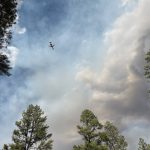
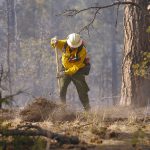



 Highway 264,
Highway 264, I-40, WB @ Winslow
I-40, WB @ Winslow